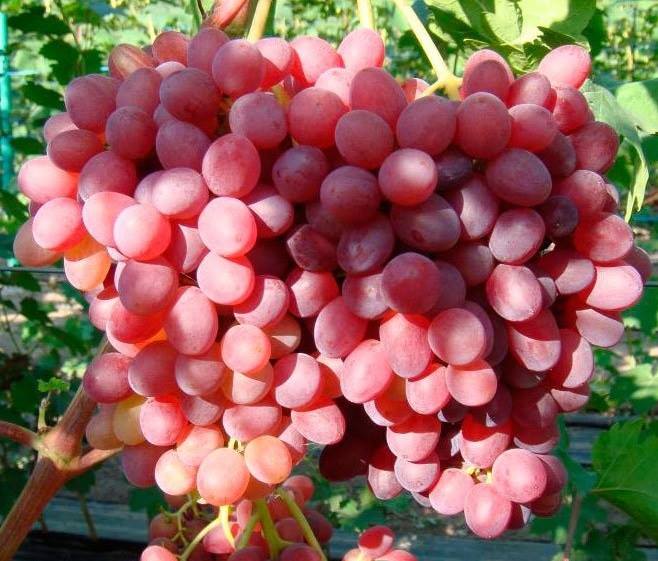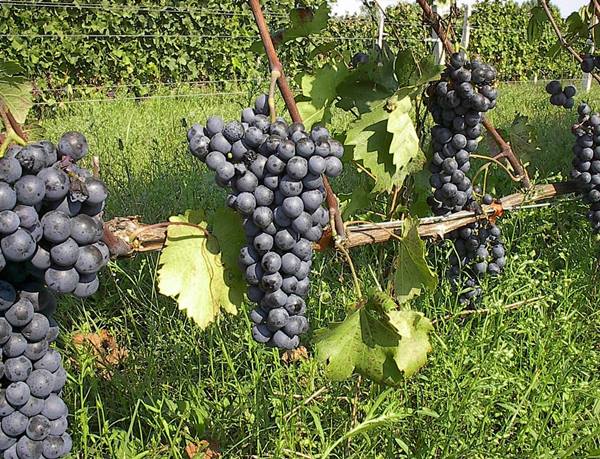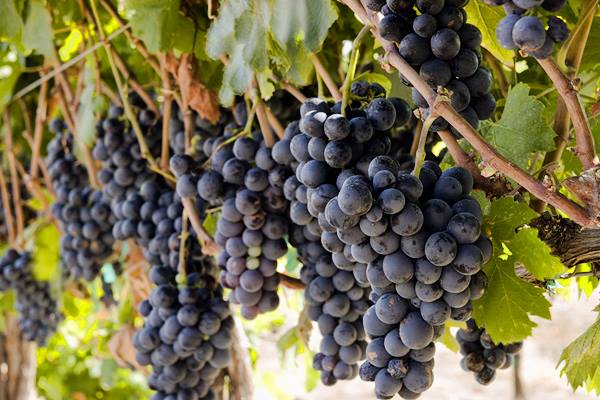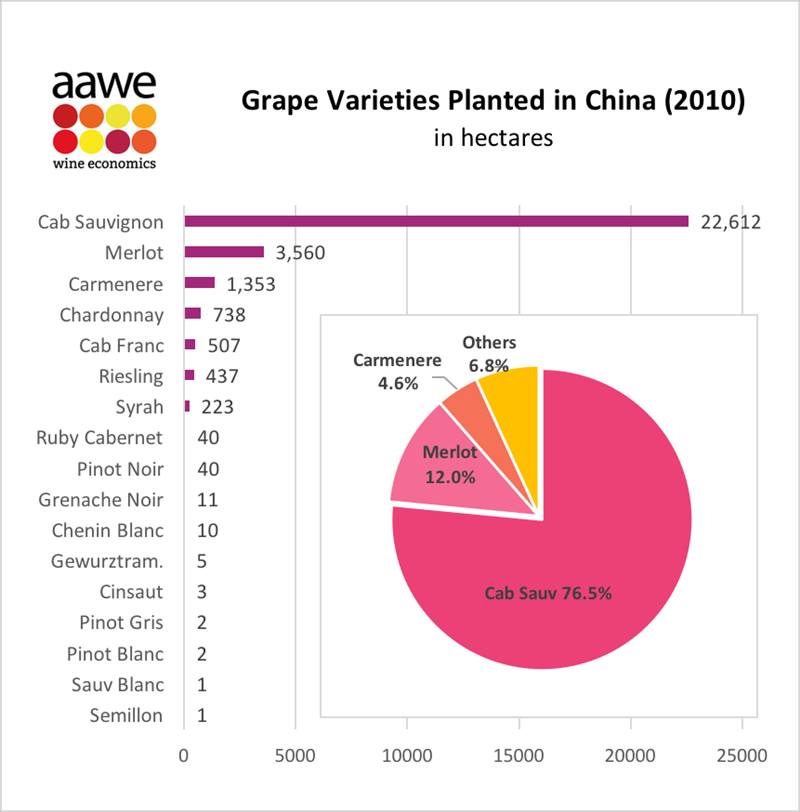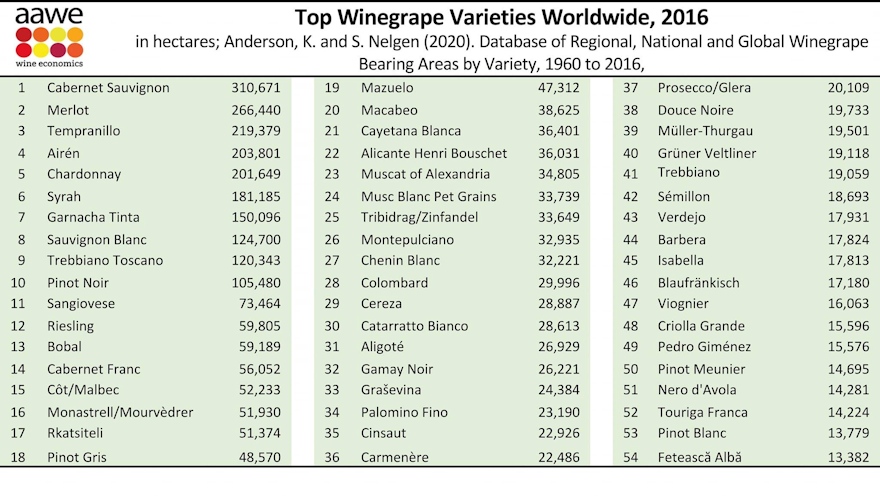Robert Bell's
Wines of Canada
Since 1992
Worlds Top Grape Varieties
under construction
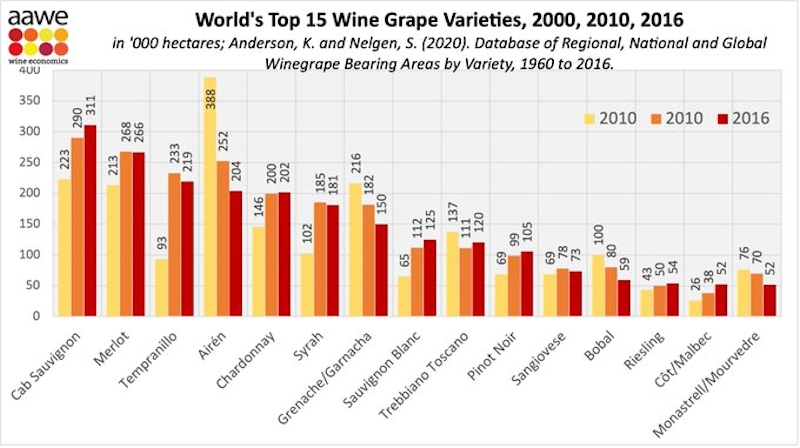
Cabernet Sauvignon is one of the world's most widely recognized red wine grape varieties. Cabernet Sauvignon became internationally recognized through its prominence in Bordeaux wines where it is often blended with Merlot and Cabernet Franc . From France , the grape spread across Europe and to the New World where it found new homes in places like California's Napa Valley , Australia's Coonawarra region Chile's Maipo Valley and British Columbia's Okanagan.
Despite its prominence in the industry, the grape is a relatively new variety, the product of a chance crossing between Cabernet franc and Sauvignon blanc during the 17th century in southwestern France . Its popularity is often attributed to its ease of cultivation—the grapes have thick skins and the vines are hardy and resistant to rot and frost —and to its consistent presentation of structure and flavours which express the typical character (" typicity ") of the variety.
In China, 79% of cultivated wine grapes are red grape varieties, and the most common include Cabernet Sauvignon, Cabernet Franc, Cabernet Gernischt, Merlot, Pinot Noir, and Vitis Amurensis Rupr; white grape varieties, such as Chardonnay, Italian Riesling, Longyan, and Ugni Blanc account for 20%, while a small quantity of teinturier grape varieties, including Alicante Bouschet and Yan 73, make up the remainder.
Good producers in Canada include Inniskillin Okanagan, Monster Vineyards, Quinta Ferrereira and Pentâge
France
The world’s best-known grape varieties come from France. Merlot, Chardonnay, Sauvignon Blanc and Syrah: a few of the very French grape varieties known the world over.
Ugni Blanc is the most planted white wine grape in France. It is also known by the name Trebbiano. . In France, it is mainly grown near Angoulême and in Gers, where it is used to make still dry wines, but it is also the variety of choice for production of Cognac and Armagnac.
Grenache (Noir) is most widely planted in the southern Rhône Valley and throughout both Provence and Languedoc-Roussillon. It is most commonly found alongside Syrah and Mourvedre in the classic Southern Rhone Blend (notably in Cotes du Rhone wines), and is the main grape variety in Chateauneuf-du-Pape.
In summary: 2020
Total shipments of Champagne in 2021 rose to 322 million bottles, an increase of 32% over 2020. The market in France was up by 25% at nearly 142 million bottles, a return to 2019 levels. Exports continued to rise, to a new record of 180 million bottles. Champagne is a sparkling wine originated and produced in the Champagne wine region of France under the rules of the appellation, that demand specific vineyard practices, sourcing of grapes exclusively from designated places within it, specific grape-pressing methods and secondary fermentation of the wine in the bottle to cause carbonation. Chardonnay, Pinot Noir, Pinot Meunier, Pinot Gris, Petit Meslier and Arbane may be used to produce Champagne. Champagne can only be made from grapes grown in France's Champagne region. Grown else where its a Sparking wine.
1. Merlot
2. Ugni blanc
3. Grenache
4. Syrah
5. Chardonnay
6. Cabernet sauvignon
7. Cabernet franc
8. Carignan
9. Pinot noir
10. Sauvignon blanc
Spain
Airén is a variety of Vitis vinifera, a white grape commonly used in winemaking. This grape is native to Spain where it represents almost a quarter of all grapes grown. It makes a nice white wine.
Bobal is a variety of Vitis vinifera, a red grape used in winemaking. It is native to the Utiel-Requena region in Valencia, Spain.
Mourvèdre is a red wine grape variety grown in many regions around the world including the Rhône and Provence regions of France, the Valencia and Jumilla and Yecla denominaciones de origen of Spain .
Portugal
In Portugal, the grape varietals range is easily above the 250 native varietals, most of which are territorially linked to Portugal for hundreds of years of natural selection. *3
Encruzado: alcoholic white grape from the Dão.
Malvasia Fina: aromatic white used all over Portugal including white port
Moscatel de Setúbal: originally introduced by the Romans, in Península de Setúbal, makes light summery wines
Sercial: the main grape used in Madeira fortified wine
Verdelho: noble white varietals of Madeira. Australia is growing this Portuguese varietal too
Alvarinho: grown in Northern Portugal and used for Vinho Verde, high quality.For Red wines
Bastardo: – literally: "bastard". This grape is grown in the Douro and Dão
Tinta Barroca: Now grown in South Africa, this ancient grape varietal, grown in the Douro for hundreds of years is one of the blender grapes for most of the Port Wines
Aragonês: In Portugal, it is used widely in Port and still reds in the Alentejo table wines
Tinto Cão: Douro grape also being used to make high quality still red wines
Touriga Nacional: One of the main and best grapes grown in Portugal. Mainly in Douro Valley for port wines
Trincadeira Preta: also called Castelão Francês
Vinhão (Souzão Douro Valley): from Vinho Verde and Minho regions.Ukraine
Vinograd Veles is a very popular grape varietal in Ukraine. Grapes "Veles" belongs to hybrids. Seedless varieties have always been highly regarded by consumers. In a short period of time, he gained popularity among the population. Although only a decade has passed since the cultivation of the variety, it has already managed to win the recognition of agronomists in many countries of the CIS and Europe.
A hybrid was bred in the city of Zaporozhye by the famous breeder Zagorulko V.V. in 2009. And already in 2010, he became one of the winners in the international competition and was awarded two gold medals. Its parents are the well-known varieties Sofia and Rusball. The hybrid is named after the god of fertility Veles.
It belongs to the early ripening varieties, from the moment the buds open until the berries fully ripen, only 100-105 days pass, while in the parental varieties the ripening period is slightly longer. However, it is worth noting that in the southern regions grape matures earlier, and in the middle zone of the country later.
The bushes grow very quickly, under appropriate conditions, the shoots fully ripen. The length of the vine grows from 3 to 5 meters. The leaves are relatively large, five-lobed, painted in a deep green color. Inflorescences are large, bisexual flowers, do not require pollinator planting. But some agronomists plant grapes nearby to bloom with Veles to increase productivity. Veles can be cultivated in the southern and middle regions of Russia and Ukraine, as well as in Belarus, Moldova and the Volga region. The variety has good winter hardiness and is able to withstand frosts down to -20 degrees Celsius.
Aligoté, also grown in Ukraine is a white grape used to make dry white wines, especially in the Burgundy region of France where it was first recorded in the 18th century. Since it is tolerant to cold, this variety is also cultivated in Eastern European countries. In 2004, it was the 22nd most planted vine variety in the world at 45,000 hectares
Switzerland.
Over 200 grape varieties are grown in Switzerland. The most popular are Chasselas (white) and Pinot Noir (red) which comprise 27 percent and 29 percent of the total production respectively. Other popular varieties include Gamay, Merlot, Humagne Rouge, Arvine and Savagnin Blanc, Gamaret, Garanoir, Pinot Gris.
Cornalin is the name given to two distinct, but related, red wine grape varieties from the Alps – one found in the Aosta Valley ("Cornalin d'Aoste") and one from Valais ("Cornalin du Valais"). Mostly grown in Switzerland. It can also be found in Italy.
Italy
Few wine countries, if any, can compete with Italy in terms of the number of grapes used for wines. The ten most planted grapes account for only 38% of the total plantings. In France the top-ten account for 70% and in Spain 75%.
Sangiovese is the most commonly planted grape in Italy is most famously used to make Chianti, a Tuscan wine named after the region in which it’s produced.Barbera is the most planted red grape variety in the northwestern region of Italy known as Piedmont
Montepulciano a red Italian wine grape variety that is most noted for being the primary grape behind the DOCG wines Offida Rosso, Montepulciano d'Abruzzo, Montepulciano d'Abruzzo Colline Teramane, Rosso Conero and the DOC wine Rosso Piceno Superiore.
Glera is a long-standing synonym of northern Italy's Prosecco grape, and the name by which it is now officially known. This green-skinned variety has been grown for hundreds of years in the Veneto and Friuli regions, most famously to produce sparkling Prosecco wines.
The Prosecco-Glera name change happened in 2009, when Conegliano-Valdobbiadene Prosecco was promoted to full DOCG status (the highest level of Italian wine quality). In light of this promotion, it was decided that the name Prosecco should be reserved exclusively for wines covered by Italy's official Prosecco appellation titles, and should not be used for the grape variety.
Pinot Gris, Merlot, Italia, Catarratto Bianco and Trebbiano Toscano are also grown.
Germany
German wine production goes back to Roman times, with many historic vineyards located along the Rhine River. Most of Germany’s wine production is in white wine because white grapes tend to thrive in cooler climates.
Riesling remains Germany's most important grape variety, with a quarter of the vineyard total planted with it. Other white grape varieties, such as Pinot Blanc, Pinot Gris and Chardonnay, are playing an increasing role.
Around a third of the German vineyard area is planted with red grape varieties. Pinot Noir leads the red wine varieties, whilst classics such as Portugieser, Schwarzriesling, Lemberger or Saint Laurent, also play an important role
Portugieser is a very old variety that probably originates in the Danube Valley (not in Portugal). This fruitful, early-ripening grape yields mild, light, easy-to-enjoy wines. A good portion of the annual crop is vinified as Weißherbst (rosé), yet even the red wines are fairly pale in colour.
Schwarzriesling Although the name literally means "black Riesling," this variety is not related to Riesling at all. In fact, it is a mutation of Spätburgunder (Pinot Noir) that ripens quite early. The wines are deep in colour, but mostly not as complex as the wines made from Spätburgunder grapes. Frequently, the Schwarzriesling is referred to by its synonym, "Müllerrebe", and in France it is known as Pinot Meunier, where it is part of many champagne cuvées.
Greece
AgiorgitikoAgiorgitiko (Greek: Αγιωργίτικο; also known as Aghiorghitiko) is a red Greek wine grape variety that, as of 2012, was the most widely planted red grape variety in Greece, ahead of Xynomavro. Agiorgitiko is a captivating grape variety that caresses the senses with elegance, freshness and intensity of aromas and flavours. It is a red grape variety and is frequently referred to as “multidynamic”, since it is capable of producing a large range of styles, from refreshing rosés to concentrated sweet wines. However, the most common expressions are two: either as a young, unoaked red wine, or as a red matured in oak for at least a year.
Xinomavro - Planted in every nook and cranny of central and northern Greece, Xinomavro is solely responsible for or participates in the PDO Naoussa, PDO Amynteo, PDO Goumenissa, and PDO Rapsani reds. It is also blended in Amynteo’s quiet dry wines and sparkling ones (POP Amynteo). “Finicky” and demanding, Xinomavro is in need of the appropriate terroir, increasing care in cultivation, low yields per hectare, and the right weather conditions in order to reveal itself in all its glory.
Assyrtiko is one of these rare white grape varieties that can grow on hot and dry climatic conditions, while at the same keeping the high alcohol in perfect balance by its crisp acidity. It is more of a textural variety, emphasizing extract, body and structure, rather than an aromatic grape. Assyrtiko originates from PDO Santorini, where it makes lean, mineral and very concentrated whites. However, it has been planted to most Greek wine regions, from other Aegean Islands to Macedonia (PDO Slopes of Meliton), Central Greece and down to the Peloponnese.
The first Cabernet Sauvignon vineyards in Greece were planted in the 1960s in Metsovo. Since then, many wine producers from every region in the country use it, considering it one of their superior wines.
Merlot appeared in Greece during the same period as Cabernet Sauvignon as it was a variety used for the production of wines similar in style to the Bordeaux wines. The first varietal Merlot emerged quite a few years later
Chardonnay was first cultivated in Attika, in the mid-1960s following the international trend of that time and soon afterwards it spread across Greece.Chardonnay performs better in cold and cool regions because it is not very drought-resistant. As a varietal wine, Chardonnay makes various wine styles; fresh and simple, complex and exuberant, austere or aromatic, with or without oak notes.
Australia
The 10 most planted grape varieties in Australia:
Syrah, 40,000 ha
Cabernet Sauvignon, 25,000 ha
Chardonnay, 21,000 ha
Merlot, 8,000 ha
Sauvignon Blanc, 6,000 ha
Pinot noir, 5,000 ha
Sémillon, 5,000 ha
Pinot Gris, 4,000 ha
Riesling, 3,000 ha
Muscat d’Alexandrie, 2,000 haNew Zealand
In the 1960's and early 1970's the principle grape varieties grown in volume were Muller Thurgau and Chenin Blanc, both of which produced large cropping volumes and non offensive medium styled wines. As New Zealanders were starting to discover the delights of table wine, these two varieties were perfect for the production of the most popular and profitable styles of wine.
From there, New Zealand wineries planted the varieties Pinotage, Sauvignon Blanc, Chardonnay and Cabernet Sauvignon and small amounts of Pinot Noir. All of these varieties were chosen based on the success in their parent countries and the New Zealand consumer’s desire to expand their range of wine knowledge and taste. This was definitely a period of personal discovery among consumers!
Pinot Noir is regarded as New Zealand's best red wine grape. With the climate of the country having similarities in some areas with Burgundy in France (from where it originates), this is perhaps not surprising. New Zealand pinot noir comes in a variety of styles.
Sauvignon blanc perhaps the wine tat put New Zealand on the world map. Chardonnay, Pinot Gris, Cabernet Sauvignon, Merlot, Syrah, Riesling, Gewurztraminer, Viognier, Malbec, Tempranillo, Marzemino, and Semillon are the top grapes of New Zealand.
Albariño, Arneis and Barbera are among the emerging varieties in New Zealand
Chile
Pais is a famous red wine grape variety in country of Chile, most planted and prominent in the Chilean wine industry. t is sometimes known as Criolla Chica in Argentina, Mission in California and Mexico, Listan Prieto and also identical to Negra Peruana. País is a very high yielding grape qualified for simple, rustic red wines but not suited for the export of premium quality wines.
Internaionally known grape varieties are cultivated in Chile, among them wine of the top ten brands, such as Chardonnay, Sauvignon Blanc, Cabernet Sauvignon, or Merlot. Cabernet Sauvignon is the most widely planted grape variety in Chile.
The Carmenère grape has become a national symbol of Chilean wines.
Alicante Bouschet or Alicante Henri Bouschet is a wine grape variety that has been widely cultivated since 1866. It is a cross of Petit Bouschet (itself a cross of the very old variety du Cher and Aramon and Grenache. Alicante is a teinturier, a grape with red flesh.
Carignane in the USA, Carignano in Italy, and Mazuelo and Cariñena in Spain, this is a variety with high acidity, high tannins, and a deep color. The Carignane vines are primarily head-trained and have late maturation. In Chile, the coastal, rainfed area is expressed very well in the regions of Maule, which features a producers’ association that has joined forces to create the shared brand of VIGNO, with specific indications for terroir, winemaking, and viticulture, while enjoying excellent results. It is an excellent variety to pair with meats, as well as sausages and dishes with smoky hints.
Cinsault is a red variety that has been known about for centuries, has its origins in the south of France, and is recognized and used in Chateauneauf du Pape and in Languedoc Rousillon. In South Africa, it was typically referred to as Hermitage. This is why, by mixing it with Pinot Noir, the Pinotage grape emerged. It withstands droughts well. In Chile, it has found its home in the country’s south-central region, more specifically in the Itata Valley. This region, also referred to as coastal and rainfed, is where we find some of the few single-variety Cinsaults that are produced, wines that have been defined by journalists as easy to drink, fresh, tremendously fruity, and which enjoy enormous potential.
Argentina
Melbec is the most popular varital in Argentia 21 % of all wine produced here.
Malbec wine is known for its deep purple color and full body. Malbec grapes are small and dark in color with very thick skins, producing a wine that has rich fruity flavors and medium tannin levels.
Malbec wines are often higher in alcohol than Merlot or Pinot Noir. Some bottles contain up to 15% ABV
Malbec grapes are fussy and can be difficult to grow, so they’re grown in much smaller quantities than other more popular red wines. Malbec grapes do well in sunny climates that also have cold nights. High elevation spots are perfect, like the Mendoza wine region nestled in the foothills of the Andes in Argentina.
Cereza Rosé, is the second most grown varital in the country. Although it has existed in Argentina for centuries, Cereza was planted in unprecedented quantities in the 1980s. It comes second to Malbec in terms of hectares planted, but because of its high yields, Cereza is actually the number one grape variety harvested each year by volume, representing 20% of Argentina’s total production. We could call it the unsung hero of Argentine wine, but in order to do that we’d need to identify Cereza’s heroic qualities…
Cereza is an incredibly vigorous variety that grows well in dry conditions and can survive in even the more saline soils. Honest? Definitely. This almost-translucent, pink-skinned variety doesn’t pretend to offer wines of concentration or colour; the darkest shade you’ll get from it is a deep rosé and you can easily make white wine from Cereza. The grapes ripen unevenly on the bunch and so you can’t macerate Cereza for too long to bring out more colour, as you’ll get bitter notes. Cereza wines are made in a lighter style and pretty much taste like the grape itself, with light, juicy fruit and sometimes floral aromas. *1
Bonarda Charbono (Bonarda) Charbono (Bonarda) is a widely traveled red-wine grape variety with a complicated history. Originally from the alpine vineyards of Savoie in eastern France, it is now mostly planted in Napa Valley, where it is known as Charbono, and in Argentina, where it goes by the name Bonarda. Over 80% of its production focuses on the province of Mendoza, the main wine region in the country and one of the most important regions in the world. Some articles place Bonarda as the second most popular grape in Argentina ahead of Cereza.
Criolla Grande Until 2006, this grape variety was the 3rd most commonly grown wine grape of Argentina with about 22,500 hectares. Criolla Grande (also known as Criolla and Criolla Grande Sanjuanina) is a red wine grape. It is different from the Chilean wine grape Pais, also known as Criolla Chica, but ampelographers believe that both grapes share a common parent, and it is now listed as a crossing of Mission and Muscat of Alexandria.
Pedro Ximénez is a variety of grapes belonging to Vitis Vinifera species. It is a white color skin grape, used for making some of the very popular sherry- type wines. The origin of this grape variety is believed to be in Spain. Some of the other names for Pedro Ximénez are; Pedro Jimenez, Perrum, Don Bueno etc.
More commonly known to the Canadaian wine consumer are Cabernet Sauvignon, Syrah, and Chardonnay
Uruguay
Uruguay is the fourth-largest wine-producing country in South America. Wine grapes have been grown here for over 250 years, although commercial viniculture did not begin until the second half of the 19th Century, two centuries or so after Chile and Argentina.*2
Tannat, the robust, tannic red that has played such a pivotal role in the country's rising wine status. Tannat is a red-wine grape whose origins lie in the Basque country, on the border between France and Spain.As Uruguayan vignerons import new Tannat clones from French vineyards, they are noticing and commenting on the softer, more powerful styles of wine the clones produce
Marselan Uruguay is the world’s second largest Marselan producer? Although it is behind France in terms of Marselan production, Uruguay has over 140 hectares of this modern variety planted. A cross between Grenache and Cabernet Sauvignon, Marselan is well suited to the humid conditions of Uruguay (with its naturally high resistance to mildew and botrytis) and can produce quality wines year on year. You can expect a medium bodied wine with finer tannins, rich colour and deep notes of cherry and blackberries from a Marselan wine.
Albariño and Cabernet Franc round out the top varitals of Uruguay.
Brazil
The primary wine-growing region of Brazil is located in its southernmost state of Rio Grande do Sul. Here, in hills far enough outside the reach of the equator, a cooler, drier climate persists throughout much of the year. Centered around the capital city of Porto Alegre is an environment that allows classic South American varietals to flourish. Tannat, malbec, cab franc, cabernet sauvignon and chardonnay are all clustered in abundance.
Italy (4,250,000 liters/year)
France (3,641,900 liters/year)
Spain (3,248,000 liters/year)
United States (2,333,900 liters/year)
Australia (1,369,000 liters/year)
Argentina (1,182,100 liters/year)
China (1,163,600 liters/year)
South Africa (1,080,100 liters/year)
Chile (949,200 liters/year)
Germany (746,200 liters/year)
China
The 5 most planted grapes in China.MXLLSIn hectares, (% of the total surface)
1.- Kyoho 372,680 (44%)
2.- Red Globe 152,460 (18%)
3.- Cabernet Sauvignon 59,290 (7%)
4.- Carmenere 8,871 (1%)
5.- Merlot 8,202 (1%)
6.- Cabernet Gernischt.Kyoho grapes are a fox grape cross popular in East Asia. The fruits are blackish-purple, or almost black, with large seeds and juicy flesh with high sugar content and mild acidity. The variety was first produced by a Japanese viniculturist, Yasushi Ohinoue in the 1930s and 1940s, by crossing Ishiharawase and Centennial grape varieties. Like the Concord, Kyoho is a slip-skin variety, meaning that the skin is easily separated from the fruit. The seeds are bitter and the skin is not traditionally eaten. The grape maintains some of the flavor qualities of the Concord, known to consumers from the flavor of most grape jellies and Concord grape juice. Not used for commercial wine product
Cabernet Gernischt is the name given to a red wine grape variety used in China. Originally believed to be of European origin, and similar if not identical to Cabernet Franc, Cabernet Gernischt has since been proven to be genetically identical to Carménère.
England
The growth in the English wine industry is amazing.
Pinot Noir: The black berried Pinot Noir is most probably the oldest of the modern Pinot clones. This ancient variety was first mentioned by Phillippe Le Hardi (Duke of Burgundy) on a democratic trip to Bruges in 1375. Originally known as either Morillon, Noirien or Auvernat, there is huge speculation about its exact origin. There is more Pinot Noir planted in the UK than there is in Portugal. English Pinot Noir, is particularly suited to Sparkling Wine production.
Pinot Noir Précoce This mutation of Pinot Noir ripens considerably earlier than its most common form. Little is known about the origin of this clone although it does have a number of synonyms that are mentioned as far back as 1690. In the UK with characteristics such as its early ripening tendencies, as well as its thicker skin, helping to protect it from rots such as botrytis - a positive in our cool, wet climate.
Chardonnay plantings are used in English Sparkling Wine production. Chardonnay in a cool climate tends to show profiles of citrus acidity and orchard fruits. It can create complex and balanced still wines whilst adding a fruit forward and linear acidity to a sparkling wine blend.
Pinot Meunier, just like Pinot Noir, is a genetic clone of Pinot
Pinot Gris is a genetic mutation of Pinot.
Bacchus a crossing of Silvaner and Riesling which was then crossed with Muller-Thurgau.First planted in the UK 1973, Bacchus became a registered variety in 1998. Bacchus can be found in British Columbia, Canada.
Ortega Bred by Hans Breider, this crossing of Muller-Thurgau and Siegerrebe first appeared in Franken, Germany, in 1948.
Madeleine X Angevine 7672 - This is a freely pollinated seedling of Madeleine Angevine, which is found more commonly in Europe as a table grape. It appeared sometime before the 1930’s and is linked to the Alzey research centre in Rheinhessen, Germany. A lesser used grape in the UK for white wines.
Solaris In 1975, Norbert Becker created a hybrid variety from Merzling and Geisenheim 6493. It is gaing in popularity with winemakers.
South Africa
The first bottle of wine was produced way back in 1659 in Cape Town by its founder, Jan van Riebeeck, during the time of the Dutch East India Company. Since then wine production in South Africa continues to centre around Cape Town, one of the country’s capital cities. The Mediterranean-type climate of South Africa makes it perfect for growing wine grapes. Because of its location and multicultural population, South Africa’s wines are a mix of Old World and New World. South Africa is also known for a signature red varietal called Pinotage. Pinotage is a cross between Pinot Noir and Cinsaut.
Pinotage is a red wine grape that is South Africa’s signature variety. The grape is a cross between Pinot Noir and Cinsault (Hermitage) and was created in 1925 by Professor Abraham Perold. The variety combines the noble characteristics of the former with the reliability of the latter.
Unique to South Africa, it can produce complex and fruity wines with age but is also often very drinkable when young. It typically produces deep red wines with smoky, bramble, and earthy flavors, sometimes with notes of tropical fruits.
Barbera, Medium to large berries, with a deep ruby color. Herbal, with bramble and ripe wild berry aromas. From herby dryness to fruity richness, with a typically brambly finish. Also reminiscent of ripe blackberry, sweet vanilla and sometimes exhibiting an earthiness. Often used as a blending component.
Cabernet Sauvignon By the 1920s it had become one of the country’s top-quality red varieties, and today it is grown in virtually all of the wine-producing areas.
Fernão Pires One of the few countries outside Portugal to cultivate this grape, where it made its mark in the drier, hotter winegrowing areas – Robertson’s Van Loveren were the first to bottle a Fernão Pires in 1982. Initially made dry and quite alcoholic, the wines have evolved, and most winemakers have settled for a far more appealing, slightly sweeter style. It still has its Muscat character but some lemony citrus fruit is usually evident these days.
Carignan was introduced to the country in the mid ’70s to boost the colour in red blends. Originally planted in areas where the soil and rainfall were good, the variety can also perform well in arid sites.
Chardonnay The variety arrived in the Cape as recently as the second half of the 20th century, initially brought in illegally by impatient vintners wanting to keep pace with world trends.
Bukettraube First imported in 1967, the variety adapted well. South Africa is one of the few wine-producing countries in the world that bottles Bukettraube as a single varietal wine. Thought to be German, though there is a variety in Alsace, France, called Bouquettraube, which is said to have originated in Würzburg and whose leaves resemble those of Elbling (another Alsace grape variety) and whose grapes are lightly Muscat-scented. “Bukett” is German for bouquet.
Colombar is a vigorous vine that does well in hot, dry climates. Both bunches and berries are medium-size and it has a thin, tough skin that’s yellowish green with a purple tinge when fully mature.South African Colombar’s high acidity and suitability to cool fermentation resulted in a discernable increase in plantings after 1970. Also termed Colombard (with a ‘d’), the variety became important to the country’s brandy industry, and reached a peak of popularity for cheap off-dry white. It is now cultivated extensively in the hot interior, often under irrigation, in the Orange and Olifants River areas, as well as in the Little Karoo and the Breede River Valley.
Crouchen BlanAmong the first varieties to arrive in the Cape a few centuries ago, Crouchen Blanc was mistaken for German Rhine or Weisser Riesling. When the real Riesling turned up, the mistake came to light but the Riesling tag stuck. Cape winemakers adopted the grape as its own, still calling it Riesling, Cape or South African Riesling (Nederburg labelled it Paarl Riesling), planting it in increasing quantities in the ’70s and ’80s. In the ’90s the variety lost ground to more popular varieties such as Sauvignon Blanc and Chardonnay.Hanepoot was one of the earliest vinous immigrants to the Cape. The origin of its name is uncertain… During the Anglo-Boer War, British soldiers nicknamed it “honeypot”, which may have became “hanepoot” in the local vernacular. It was only in the 1920s that Stellenbosch University professor Abraham Perold proved conclusively that Hanepoot and Muscat d’Alexandrie were one and the same. It is perhaps best known in its fortified form as Jerepigo and Muscadel. It is also widely sold as table grapes and used in the production of raisins, grape juice and concentrate.
Chenin Blanc accounts for 19% of the grapes grown in South Africa..
Among the other whites Roussanne, Sauvignon Blanc, Semillon, Sylvaner, Viognier
Cabernet Franc, Cinsaut, Gamay Noir, Grenache, Malbec, Merlot, Mourvèdre, Nebbiolo, Petit Verdot, Pinot Meunier, Pinot Noir Pontac, Ruby Cabernet, Sangiovese, Shiraz / Syrah, Sousão, Tempranillo (Tinta Roriz),Tinta Barroca, Touriga , Naçional, and Zinfandel
Czech Republic
Wine production in the Czech Republic is divided into two distinct worlds. The Moravian wine country in the southeast is prolific and densely planted. Meanwhile Bohemia in the northwest is characterized by smaller, more traditional family-run wineries. Bohemia's fragmented patches of vineyard are to the north of Prague, in the Litomerice and Melnik regions.
The principal grape varieties grown in the Czech Republic are associated with aromatic white wines. These include the Alsace trio of Gewürztraminer (Tramín Ceverný), Pinot Gris (Rulandské Šedé) and Riesling (Ryzlink Rýnský).
Sauvignon Blanc also does well here, and benefits from the same extended ripening period and high sunshine hours it enjoys in New Zealand's Marlborough region. The Grüner Veltliner grape, popular worldwide in wines from its native Austria, may soon be a standard bearer for Czech wines too
Winegrape varieties World Wide
Note: Not all resources had the same findings..
*1 South America Wine Guide
*2 Wine- Searcher
*3 Wine Tourium in Portugal
*4 Wine Grapes by Jancis Robinson, Julia Harding and José Vouilamoz (Robinson, J.,Harding,J. and Vouillamoz,J., 2012. Wine Grapes. New York: Ecco/Harper Collins.)Resoures
Britt Karlsson
Wines of Germany
Gino Pinto
Top Wines
Wine-Research
The Wine Society
aawe
Varieties found in Canada.
|

Home | Site map | Robert's Selection |New | Contact Us | ©2021 Robert A Bell
